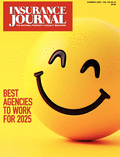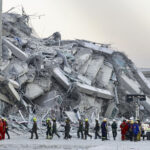Have you ever wondered how modern-day fire departments began? Or why agents buy E&O coverage? What about when the first business owners policy launched? These are just a few questions that Insurance Journal and Claims Journal editors will answer for you in this year’s Market Fact Book.
Derived from various industry sources, as well as Insurance Journal‘s own database, here’s the 2011 collection of some of the more interesting (and perhaps not so interesting) insurance facts and figures for your reading pleasure. We hope you enjoy!
Fire Fighters
Fire insurance carriers may have been a major impetus for modern paid fire departments. Prior to the creation of municipal fire departments, volunteer fire departments, having no clear district lines, “competed” with one another to extinguish fires — the department that arrived at the fire first and successfully doused the flames got paid (yes, there was a profit and even political motive).
As the number of fire insurance companies grew so too did the competition among fire departments. Insurance carriers would supply its insureds with “fire brand” placards (you may have seen some in antique shops) to be placed on the front of the building to indicate that there was insurance coverage and which carrier provided the protection (so the department would know who to bill). Fire departments knew that if insurance coverage was in place they would get paid more and more quickly than just trying to bill the building’s owner.
Fire insurance companies, looking for a better way to protect their investment, eventually formed their own fire brigades. When a fire alarm sounded all the local insurance company fire departments would respond; if the insurance carrier’s brigade arrived first but did not find their fire brand on the building, legend tells us they would watch it burn, letting the next department to arrive fight the fire.
Insurance Industry by Numbers
- Property/casualty industry’s net premiums written total $426 billion
- 2,689 P/C insurance companies in U.S.
- U.S. insurance industry employs 2.2 million people
- Insurance industry paid $15.8 billion in premium taxes in 2010
- Of 23 top P/C insurers, 12 had 100+ combined ratio in latest quarter
- Insurers’ 2011 nine-month profit down 60 percent from last year
B-BOPs
The business owners policy (BOP) was first introduced in 1976. This was the first time commercial risks were offered property and liability coverage in the same coverage form without the need to piecemeal the parts together in a package.
ISO and AAIS
Insurance Services Office (ISO) was founded and created in 1971 by a merger between the Mutual Insurance Rating Bureau and the Insurance Rating Bureau (known as the National Bureau of Casualty Underwriters until 1968).
American Association of Insurance Services (AAIS) was organized in 1975 as a multiline property/casualty advisory organization and as a licensed statistical agent. AAIS is the successor organization of the former Transportation Insurance Rating Bureau, a Chicago-based inland marine rating bureau formed from the merger of two smaller bureaus founded in the 1930s.
These two organizations are largely responsible for the standardization enjoyed in the industry today. Although their forms and rates (loss costs) may be held out as advisory, they are considered the standards on which proprietary forms and rates are based.
Renters’ Premium
The average renters insurance policy premium is about $173 a year, according to the National Association of Insurance Commissioners (NAIC). Still, only 43 percent of renters buy renters insurance, according to the Insurance Research Council. More than 96 percent of homeowners have insurance on their home.
Independent Agents’ E&O
The vast majority of agency owners (86.5 percent) say they buy agency E&O coverage to protect the assets of their agency, according to Insurance Journal‘s 2011 Agency E&O Survey.
Truck Sales Up
Pickup trucks, SUVs, crossovers and, in Chrysler’s case, minivans accounted for 65.8 percent of General Motors, Ford and Chrysler 2011 sales through November, according to Autodata. That’s up from 64 percent last year and the domestic automakers’ heaviest truck concentration since 66.3 percent in 2004.
China Commercial Auto
The world’s largest auto market, China, permits foreign insurers to sell commercial auto policies in competition with state-backed insurers but prices are tightly controlled. That may be about to change, however. In September, the China Insurance Regulatory Commission published draft rules to reform the pricing of commercial auto insurance policies. The chairman of the Insurance Association of China told Reuters that officials want to introduce more competition into the market that is now dominated by 34 Chinese insurers including PICC Property and Casualty Co. and Ping An Insurance. Currently, 19 foreign property/casualty insurance companies operate in China, including Tokio Marine & Nichido Fire Insurance Co, Chubb and RSA Insurance Group.
Home Claims
In 2009, 6 percent of insured homes had a claim, according to ISO. About 95 percent of those claims were for property damage, including theft.
Revenue per Employee
Revenue per agency employee remained flat in 2010 with the average for agencies under $5 million in revenues just over $150,000 and agencies with more than $5 million at $172,000, according to the Insurance Agents & Brokers of America’s 2011 Best Practices Study.
Backbone of U.S. Economy
The insurance industry continues to be a major sector in the American economy, in terms of the business it generates, the number of people it employs, and the amount of tax it pays to Uncle Sam. P/C and life/health insurance companies paid $15.8 billion in premium taxes in 2010, or $51 for every person living in the United States.
Insurance carriers and related activities accounted for $425 billion, or 3.0 percent of U.S. gross domestic product in 2009, according to the Insurance Information Institute.
The U.S. insurance industry’s net premiums totaled $1.0 trillion in 2010, with premiums recorded by life/health insurers accounting for 58 percent and premiums by P/C insurers accounting for 42 percent. Net premiums written totaled $426 billion in 2010, according to SNL Financial.
Earnings Fell Off a Cliff in 2011
This was a year when most P/C insurers saw their income take a nosedive. Fitch reported that a group of 47 publicly traded P/C insurers and reinsurers it tracks had a net profit of $9.7 billion for the first nine months of 2011, down more than 60 percent from one year ago when the same group reported a profit of $26.4 billion.
Moody’s Investors Service also reported that for the latest, third-quarter earnings, 23 P/C insurers it follows reported $1.6 billion in composite income, a whopping 70 percent decline compared to one year ago.
Half of U.S. Market
There are many P/C insurance companies in the United States, but the 10 biggest insurers control the lion’s share of the market. State Farm Mutual Automobile Insurance, the biggest writer of P/C/ insurance with $52.38 billion in direct premiums written, had 10.9 percent of the U.S. market share in 2010. Zurich Financial Services comes in second place, with $27.44 billion in direct premiums written and 5.7 percent of the market. Allstate comes in third, with $25.86 billion and a 5.4 percent market share.
The top three are followed by AIG (5.3 percent market share), Liberty Mutual (5.3 percent), Travelers (4.5 percent), Berkshire Hathaway (3.4 percent), Nationwide Mutual (3.1 percent), Progressive (3.1 percent) and USAA Insurance (2.3 percent).
Together, these 10 biggest writers of P/C insurance have 49 percent of the U.S. market.
Health Insurance Gets Costlier
Companies shell out big bucks to offer employees health benefits, and the cost continues to go up. The average cost of providing health benefits for each employee rose to $10,146 in 2011, up 6.1 percent from last year, according to benefits consulting firm Mercer. It’s the first time that it has topped $10,000. On a brighter note, the pace of cost increases slowed down in 2011.
Piracy Bedevils Marine Commerce
Piracy is costing the world’s ship owners and charterers more than $9 billion a year, and it’s growing. Somali pirates, making use of “mother ships” have mounted attacks within 150 miles of South African and Pakistani waters and 250 miles of India. As of the end of September 625 crew members had been taken by the pirates.
But although Somali pirates are initiating more attacks — 199 as of the end of September — up from 126 for the first nine months of 2010 — they are actually hIJacking fewer vessels. Only 24 ships have been successfully taken this year, compared with 35 for the same period in 2010. HIJackings were successful in just 12 percent of all attempts this year, down from 28 percent in 2011.
Cat Losses Explode in 2011
Catastrophe losses reached near record proportions in 2011 — $67 billion — and that was at the beginning of September. Floods in Australia, earthquakes in New Zealand and Japan, which was also hit by a giant tsunami, tornadoes in the United States and four months of floods in Thailand were the most costly.
Damaging Tornadoes
According to the National Weather Service (NWS), there have been a total of 58 classified F5 and EF5 rated tornadoes in the United States recorded between 1950 and 2011. The tornado that destroyed parts of Joplin, Mo., on May 22 of this year (number 57 on the NWS list) caused an estimated $1.9 billion in insured losses, according to the Missouri Department of Insurance.
Flood Insurance
Less than a fifth of U.S. homeowners have a flood insurance policy that protects their property and personal belongings, even though four-out-of-five natural disasters in the United States involve flooding, according to the Insurance Information Institute.
Lloyd’s Still Covers Bizarre Risks
Lloyd’s has insured a football player’s hair, the anatomical attributes of various celebrities, and even a Frenchman’s heroic crossing of the English Channel in a bathtub. Its latest venture in the strange risk category involves English adventuress and world record holder Sarah Outen. She has embarked on a two and a half year journey to kayak, cycle and row around the world, and she’s now covered by a £1.25 million [$2 million] insurance policy, which Lloyd’s said was “one of the most complex policies” it has written in years.
Declining Employment
As of September 2011, there were 2,203,700 people working the insurance industry, according to the Insurance Information Institute. That number encompasses all sectors of the industry. The number was down slightly from that of the previous month; in August 2011 total employment in the insurance industry (all sectors) was 2,211,100. Employment at agencies and brokerages (for all types of insurance) also fell between December 2007 and September 2011 — by 6.1 percent to 641,300.
Top OSHA Violation in 2011
OSHA released the most frequently cited standards in fiscal year 2011 (Oct. 1, 2010 through Sept. 30, 2011). The top violation was lack of fall protection at construction sites.
Vehicle Theft
According to the National Insurance Crime Bureau (NICB) 2010 Hot Wheels report, Hondas topped the list for most stolen vehicles. The top five stolen vehicles included the 1994 Honda Accord, 1995 Honda Civic, 1991 Toyota Camry, 1999 full size Chevy pickup truck and 1997 Ford F150 pickup truck.
Green Building and Insurance
Leadership in Energy & Environmental Design (LEED)-certified existing buildings are outpacing their newly built counterparts, according to the U.S. Green Building Council. As of December, square footage of LEED-certified existing buildings surpassed LEED-certified new construction by 15-million square feet on a cumulative basis.
Technology Risks
Technology risks of all sorts are a growing concern for companies and individuals. According to the Federal Bureau of Investigations’ latest Internet crime report, the top 10 cybercrimes were: Non-delivery of payment or merchandise; FBI related scams; identity theft; computer crimes; miscellaneous fraud; advance fee fraud; spam; auction fraud; credit card fraud; overpayment fraud.
Slip and Fall Trends
The National Floor Safety Institute reports the five major causes for claims involving slip and falls are walking surfaces, footwear, hazard warning, training and fraud.
Topics Catastrophe USA Carriers Agencies Profit Loss Auto Fraud Flood China Property Market Property Casualty Casualty Construction
Was this article valuable?
Here are more articles you may enjoy.


 Natural Disaster Claims in 2025 to Again Top $100B Despite ‘Abnormally Low’ Q3 Events
Natural Disaster Claims in 2025 to Again Top $100B Despite ‘Abnormally Low’ Q3 Events  Illinois Sues State Farm for Refusal to Release Homeowners’ Insurance Data
Illinois Sues State Farm for Refusal to Release Homeowners’ Insurance Data  All Commercial Insurance Lines Except One in ‘Soft-Market Territory’: WTW
All Commercial Insurance Lines Except One in ‘Soft-Market Territory’: WTW  ‘Catastrophic’ Hacks Warning Follows Intrusion of Cyber Firm F5
‘Catastrophic’ Hacks Warning Follows Intrusion of Cyber Firm F5 


